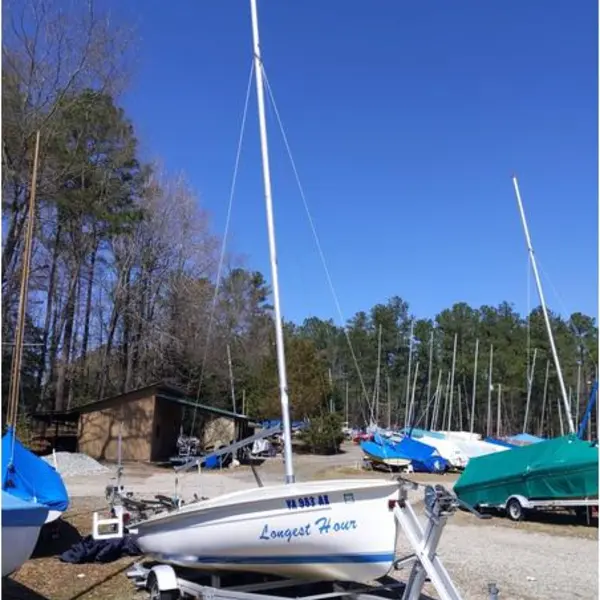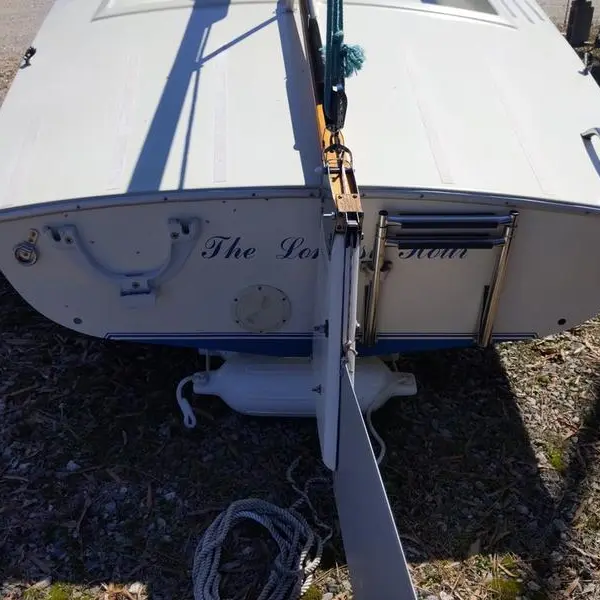Seller's Description
The Flying Scot is an American sailing dinghy that was designed by Sandy Douglass as a one-design racer and first built in 1958. The Flying Scot is a recreational sailboat, built predominantly of fiberglass with a balsa core. It has a fractional sloop rig with aluminum spars. The hull has a raked stem, a plumb transom, a transom-hung rudder controlled by a tiller and a retractable centerboard that weighs 105 lb (48 kg) and is raised with a 6:1 mechanical advantage assist. The boat displaces 850 lb (386 kg) and has foam flotation under the seats for safety. The hulls are all one-design and built from the same molds. The boat has a draft of 4.00 ft (1.22 m) with the centerboard extended and 8 in (20 cm) with it retracted, allowing beaching or ground transportation on a trailer. For sailing the design is equipped with a spinnaker of 200 sq ft (19 m2). The boat is supported by an active class association, the Flying Scot Sailing Association, which controls the boat’s design and organizes racing regattas. In a 1994 review. Capacity is eight adults. The design was inducted into the American Sailboat Hall of Fame in 1998. The citation says in part: “a hotshot small boat sailor with a penchant for planing, Designer Gordon “Sandy” Douglass reined in his desire for all-out performance to produce a moderate boat that could still sail well, but be managed easily by a couple.
Equipment: Trailer Mast raising bipod Inflatable bow bag flotation 1 sets of Infinty sails (very good condition) 1 set of Infinity cruising sails with reef points (excellent condition) 1 Spinnaker plus spinnaker pole 2 boat cushions 2 paddles Minnkota electric motor 3 marine batteries with case Spare hardware, wind vanes etc.
Specs
- Designer
- Gordon K. (Sandy) Douglass
- Builders
- Tanzer Industries Ltd.
- Douglass & McLeod
- Customflex
- Flying Scot, Inc.
- Loftland Sail-craft Inc.
- Association
- Flying Scott (USA)
- # Built
- 5300
- Hull
- Monohull Dinghy
- Keel
- Centerboard
- Rudder
- ?
- Construction
- FG
Dimensions
- Length Overall
- 18′ 11″ / 5.8 m
- Waterline Length
- 18′ 6″ / 5.6 m
- Beam
- 4′ 11″ / 1.5 m
- Draft
- 0′ 9″ / 0.2 m — 1′ 6″ / 0.5 m
- Displacement
- 850 lb / 386 kg
- Ballast
- ?
Rig and Sails
- Type
- Sloop
- Reported Sail Area
- 191′² / 17.7 m²
- Total Sail Area
- ?
Mainsail
- Sail Area
- ?
- P
- ?
- E
- ?
- Air Draft
- ?
Foresail
- Sail Area
- ?
- I
- ?
- J
- ?
- Forestay Length
- ?
Auxilary Power
- Make
- ?
- Model
- ?
- HP
- ?
- Fuel Type
- ?
- Fuel Capacity
- ?
- Engine Hours
- ?
Accomodations
- Water Capacity
- ?
- Holding Tank Capacity
- ?
- Headroom
- ?
- Cabins
- ?
Calculations
- Hull Speed
-
10.0 kn
Classic: 5.76 kn
Hull Speed
The theoretical maximum speed that a displacement hull can move efficiently through the water is determined by it's waterline length and displacement. It may be unable to reach this speed if the boat is underpowered or heavily loaded, though it may exceed this speed given enough power. Read more.
Formula
Classic hull speed formula:
Hull Speed = 1.34 x √LWL
A more accurate formula devised by Dave Gerr in The Propeller Handbook replaces the Speed/Length ratio constant of 1.34 with a calculation based on the Displacement/Length ratio.
Max Speed/Length ratio = 8.26 ÷ Displacement/Length ratio.311
Hull Speed = Max Speed/Length ratio x √LWL
- Sail Area/Displacement
-
34.0
>20: high performance
Sail Area / Displacement Ratio
A measure of the power of the sails relative to the weight of the boat. The higher the number, the higher the performance, but the harder the boat will be to handle. This ratio is a "non-dimensional" value that facilitates comparisons between boats of different types and sizes. Read more.
Formula
SA/D = SA ÷ (D ÷ 64)2/3
- SA: Sail area in square feet, derived by adding the mainsail area to 100% of the foretriangle area (the lateral area above the deck between the mast and the forestay).
- D: Displacement in pounds.
- Ballast/Displacement
- ?
Ballast / Displacement Ratio
A measure of the stability of a boat's hull that suggests how well a monohull will stand up to its sails. The ballast displacement ratio indicates how much of the weight of a boat is placed for maximum stability against capsizing and is an indicator of stiffness and resistance to capsize.
Formula
Ballast / Displacement * 100
- Displacement/Length
-
60.0
<100: Ultralight
Displacement / Length Ratio
A measure of the weight of the boat relative to it's length at the waterline. The higher a boat’s D/L ratio, the more easily it will carry a load and the more comfortable its motion will be. The lower a boat's ratio is, the less power it takes to drive the boat to its nominal hull speed or beyond. Read more.
Formula
D/L = (D ÷ 2240) ÷ (0.01 x LWL)³
- D: Displacement of the boat in pounds.
- LWL: Waterline length in feet
- Comfort Ratio
-
5.5
<20: lightweight racing boat
Comfort Ratio
This ratio assess how quickly and abruptly a boat’s hull reacts to waves in a significant seaway, these being the elements of a boat’s motion most likely to cause seasickness. Read more.
Formula
Comfort ratio = D ÷ (.65 x (.7 LWL + .3 LOA) x Beam1.33)
- D: Displacement of the boat in pounds
- LWL: Waterline length in feet
- LOA: Length overall in feet
- Beam: Width of boat at the widest point in feet
- Capsize Screening
-
2.9
>2.0: better suited for coastal cruising
Capsize Screening Formula
This formula attempts to indicate whether a given boat might be too wide and light to readily right itself after being overturned in extreme conditions. Read more.
Formula
CSV = Beam ÷ ³√(D / 64)
- Beam: Width of boat at the widest point in feet
- D: Displacement of the boat in pounds
This listing is presented by SailboatListings.com. Visit their website for more information or to contact the seller.














